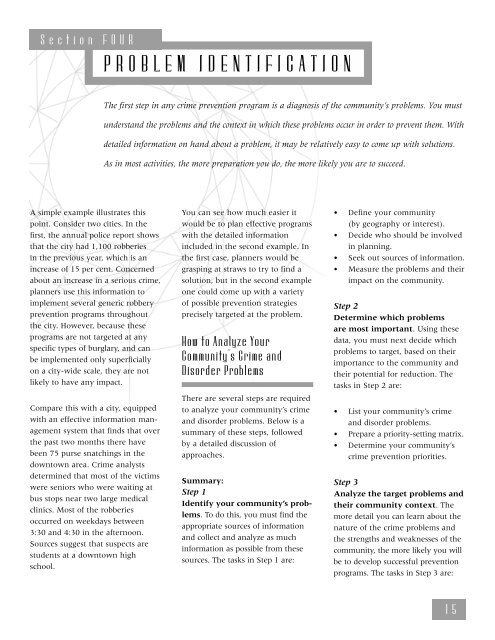Primer on Municipal Crime Prevention - FCM
Primer on Municipal Crime Prevention - FCM
Primer on Municipal Crime Prevention - FCM
Create successful ePaper yourself
Turn your PDF publications into a flip-book with our unique Google optimized e-Paper software.
S e c t i o n F O U R<br />
PROBLEM IDENTIFICATION<br />
A simple example illustrates this<br />
point. C<strong>on</strong>sider two cities. In the<br />
first, the annual police report shows<br />
that the city had 1,100 robberies<br />
in the previous year, which is an<br />
increase of 15 per cent. C<strong>on</strong>cerned<br />
about an increase in a serious crime,<br />
planners use this informati<strong>on</strong> to<br />
implement several generic robbery<br />
preventi<strong>on</strong> programs throughout<br />
the city. However, because these<br />
programs are not targeted at any<br />
specific types of burglary, and can<br />
be implemented <strong>on</strong>ly superficially<br />
<strong>on</strong> a city-wide scale, they are not<br />
likely to have any impact.<br />
Compare this with a city, equipped<br />
with an effective informati<strong>on</strong> management<br />
system that finds that over<br />
the past two m<strong>on</strong>ths there have<br />
been 75 purse snatchings in the<br />
downtown area. <strong>Crime</strong> analysts<br />
determined that most of the victims<br />
were seniors who were waiting at<br />
bus stops near two large medical<br />
clinics. Most of the robberies<br />
occurred <strong>on</strong> weekdays between<br />
3:30 and 4:30 in the afterno<strong>on</strong>.<br />
Sources suggest that suspects are<br />
students at a downtown high<br />
school.<br />
The first step in any crime preventi<strong>on</strong> program is a diagnosis of the community’s problems. You must<br />
understand the problems and the c<strong>on</strong>text in which these problems occur in order to prevent them. With<br />
detailed informati<strong>on</strong> <strong>on</strong> hand about a problem, it may be relatively easy to come up with soluti<strong>on</strong>s.<br />
As in most activities, the more preparati<strong>on</strong> you do, the more likely you are to succeed.<br />
You can see how much easier it<br />
would be to plan effective programs<br />
with the detailed informati<strong>on</strong><br />
included in the sec<strong>on</strong>d example. In<br />
the first case, planners would be<br />
grasping at straws to try to find a<br />
soluti<strong>on</strong>, but in the sec<strong>on</strong>d example<br />
<strong>on</strong>e could come up with a variety<br />
of possible preventi<strong>on</strong> strategies<br />
precisely targeted at the problem.<br />
How to Analyze Your<br />
Community’s <strong>Crime</strong> and<br />
Disorder Problems<br />
There are several steps are required<br />
to analyze your community’s crime<br />
and disorder problems. Below is a<br />
summary of these steps, followed<br />
by a detailed discussi<strong>on</strong> of<br />
approaches.<br />
Summary:<br />
Step 1<br />
Identify your community’s problems.<br />
To do this, you must find the<br />
appropriate sources of informati<strong>on</strong><br />
and collect and analyze as much<br />
informati<strong>on</strong> as possible from these<br />
sources. The tasks in Step 1 are:<br />
• Define your community<br />
(by geography or interest).<br />
• Decide who should be involved<br />
in planning.<br />
• Seek out sources of informati<strong>on</strong>.<br />
• Measure the problems and their<br />
impact <strong>on</strong> the community.<br />
Step 2<br />
Determine which problems<br />
are most important. Using these<br />
data, you must next decide which<br />
problems to target, based <strong>on</strong> their<br />
importance to the community and<br />
their potential for reducti<strong>on</strong>. The<br />
tasks in Step 2 are:<br />
• List your community’s crime<br />
and disorder problems.<br />
• Prepare a priority-setting matrix.<br />
• Determine your community’s<br />
crime preventi<strong>on</strong> priorities.<br />
Step 3<br />
Analyze the target problems and<br />
their community c<strong>on</strong>text. The<br />
more detail you can learn about the<br />
nature of the crime problems and<br />
the strengths and weaknesses of the<br />
community, the more likely you will<br />
be to develop successful preventi<strong>on</strong><br />
programs. The tasks in Step 3 are:<br />
1 5

















